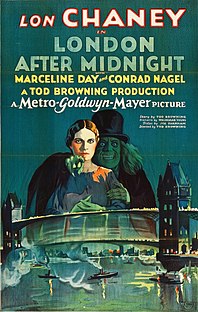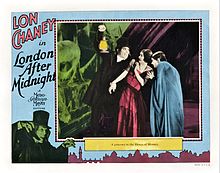At midnight (1927)
| Movie | |
|---|---|
| German title | At midnight |
| Original title | London After Midnight |
| Country of production | United States |
| original language | English |
| Publishing year | 1927 |
| length | 63 (original version), 48 (reconstruction) minutes |
| Rod | |
| Director | Death Browning |
| script | Waldemar Young |
| production | Rick Schmidlin |
| music | Robert Israel |
| camera | Merritt B. Gerstad |
| cut | Christopher Gray |
| occupation | |
| |
Midnight from 1927 is a silent film by the American director Tod Browning . The early horror film is considered to be one of the most wanted lost films.
action
London in the 1920s: Scotland Yard's Inspector Edward Burke is investigating the case of Sir Roger Balfour, who was shot dead in his villa. Also present at the scene are Sir James Hamlin, neighbor and friend of the dead man, as well as Lucille, his daughter, and the butler Williams. Despite Sir James' concerns, Burke believes that the cause of death is suicide, based on Balfour's suicide note.
When five years later a mysterious stranger, accompanied by a woman, moves into Balfour's property and Balfour's crypt is found empty, Burke resumes the investigation. Could it be that Balfour was resurrected a vampire ? It turns out that Sir James murdered Balfour at the time and that the vampires were not real vampires, but a production by Burke to determine the culprit.
background
In 1935, the film came to MGM Studios' archive number 7 and was destroyed in 1967 when the archive burned out. Film historians Willam K. Everson and David S. Bradley were the last to see the film when they drew a comparison between the film and The Mark of the Vampire from 1935 in 1953 (Death Browning's remake of At Midnight ). The chances of a copy of the film showing up are considered slim, as MGM did not give the film to other distributors.
In 2002 the film historian Rick Schmidlin produced a documentary on behalf of the TV station Turner Classic Movies , which attempted to reconstruct the film based on the script and around 200 still images.
Reviews
At midnight when it was released it was a commercial success. However, the opinions of the critics of the time were only mixed. The New York Times criticized the "somewhat incoherent narrative style," while Moving Picture World highlighted the achievements of Lon Chaney and Henry Walthall. The industry journal Variety did not find the film to be the strongest of Lon Chaney and director Tod Browning. There are no current reviews of the film for obvious reasons.
Web links
- At midnight in the Internet Movie Database (English)
- Retro-Park - A detailed chapter on the film in the “Document of Horror”, from page 355

